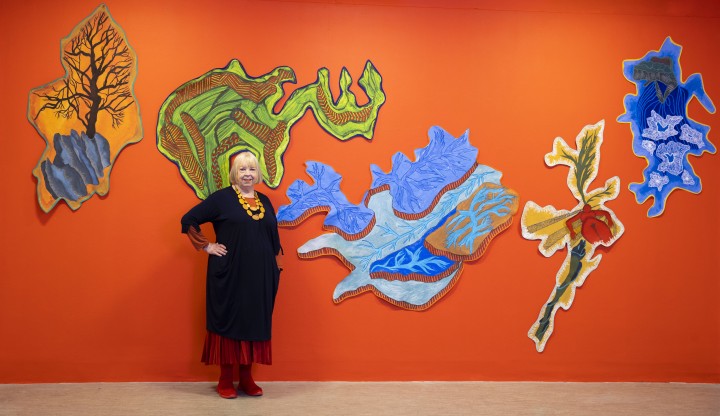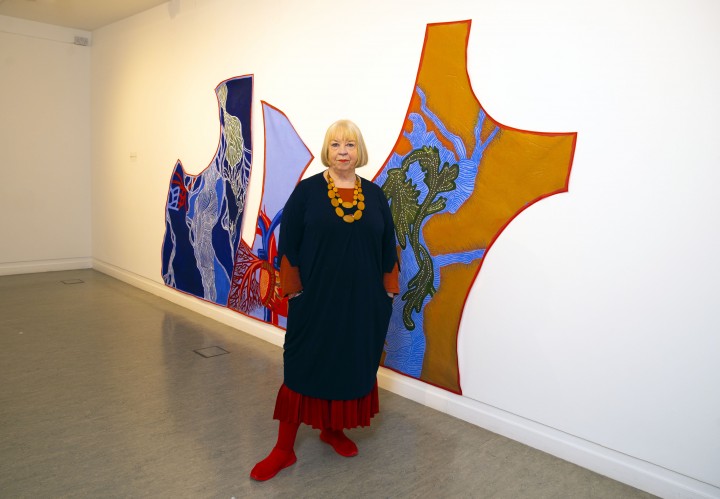Scottish Art News
Latest news
Magazine
News & Press
Publications
Lady in Red
By Susan Mansfield, 10.01.2024

The title of her 1987 exhibition at Glasgow’s Third Eye Centre, Why I Choose Red, comes from a poem by Hugh MacDiarmid, the last line of which reads “a man in a red shirt can neither hide nor retreat”. “And in my head I always change that to ‘a woman in a red dress can neither hide nor retreat’,” she says. It was a provocation to herself, a woman in a (largely) male art school, in a male city. It’s a maxim she has followed ever since.
 Image courtesy of the Artist and GoMA
Image courtesy of the Artist and GoMA
We meet at her current exhibition, Wednesday is Cobalt Blue, Friday is Cadmium Red, at GoMA in Glasgow, her first institutional show in the city since 1987. A thread - a red thread, perhaps - connects that show to this: she has remade one of the original works. Now called Six Fires, the work celebrates ‘Passion’, ‘Imagination’ and ‘Conscience’, “a kind of personal mantra that sums up what I’m about”.
At 73, Ainsley, who walks with a stick since an accident in Iceland a few years ago, is no less formidable than one would expect. The show is not the major retrospective many would argue she deserves; instead she has filled the space available with new work. Meanwhile, two of her former students, John Beagles and Graham Ramsay, occupy the ground floor space: “I’ve trained them well!” she chuckles.
“I spoke at a conference recently called Creativity and Ageing,” she tells me, over coffee. “I said it should be called Creativity and Ageism, because it’s only recently that older artists, especially older women artists, have been given any focus at all. There’s such a focus on emerging artists - and I don’t resent that, I’m so supportive of my students’ work - but sometimes I did feel a bit invisible, at least in my own country.”
An ambitious solo show at An Tobar in Mull in 2017 helped turn that tide. In the same year, she was elected to the RSA and named an ‘Outstanding Woman of Scotland’ by the Saltire Society. She has since had solo exhibitions at the RSA in Edinburgh and in Leeds, and her work is included in the Women in Revolt exhibition currently at Tate Britain (it travels to National Galleries of Scotland: Modern Two in May).
The driving interests of her practice have remained largely consistent: the metaphors which connect landscape and the body; the microscopic (blood vessels, arteries) and macroscopic (rivers, glaciers, contours of the land); northernness, from her native Northumberland to the Arctic Circle; a passion for maps; a love of literature; a ready engagement with politics, feminism, and now climate change.
“You can’t be interested in the natural world and landscape and not see what’s happening in the world around us. I’m scared about the planet. I’m scared about the swing to the far Right in practically every country, the possibility of Trump getting back in again, and the rolling back of abortion rights in America. It’s hard to find joy in the midst of all that, but at the same time I think you just have to speak out and keep on going. We all have fears in the middle of the night when you think: ‘Is art important? Is what I’m doing of any interest?’ I have to psyche myself up sometimes to keep going.”
Ainsley came, she says, from “tough beginnings”. She grew up on the notorious Meadow Well estate in North Shields. Her parents were against her going to art school; “they wanted me to get a job and bring money into the family,” but came round in the end, helping to care for her son, Simon, who was born while she was a student.
After Newcastle Polytechnic (“I never met a female tutor”), she headed for postgraduate studies at Edinburgh College of Art, where Maureen Hodge gave her a berth in the Tapestry Department (“I’ve never done a tapestry in my life, but she liked my work and allowed me to do anything I wanted, basically”). Here, she began her lifelong love affair with colour, particularly red.
“I’d been to Japan and was really influenced by Japanese culture and all things minimal. Then I got to the stage where I realised I wasn’t minimalist, I was maximalist, and I wanted colour in my work. It was black and white and red for a while, and then I started to introduce other colours including ultramarine and cobalt blue, because I always think of them as male colours and red as the female colour. This thing called simultaneous contrast happens where they vibrate against each other and I really like that because it seems to me that’s what happens between the male and female of the species!” She laughs, throatily.
When she applied for a one-day-per-week teaching job in the Murals Department at GSA, she believes she got the interview because the head of department thought she was a man. However, by 1986, Murals had become Environmental Art, and she was teaching full-time alongside David Harding, raising a generation of Scottish artists who included Douglas Gordon, Christine Borland and Ross Sinclair.
Her exhibition, Why I Choose Red, was a bold statement at the time in a male-dominated GSA in thrall to the New Glasgow Boys. “I think I was very aware of a kind of macho quality to a lot of the work that was going on at the time, in Glasgow and internationally. I guess I wanted to celebrate other qualities, empowerment, a sense of community, visibility, and the relationship between the work you make and your philosophy of life, what you believe in. I made these warrior women, twice life size - in fact everything in the show was twice life size.”
When she was invited (with Roger Palmer and the late John Calcutt) to set up the now-celebrated MFA course at GSA in 1991, a programme she headed up until her retirement in 2005, this left even less time for her own artistic practice. However, she knew she was setting an important example for her students, particularly the women.
“Teaching’s hard, it takes a lot out of you. But if you’re a committed teacher, you have to make time for your own work, even if sometimes it’s not visible. I kept it going on evenings, weekends, holidays, and when I’d accumulated enough work, I’d try to have an exhibition. I think you have to make time for the things that are really important to you, however difficult it is, and try to make a contribution in some way to the world we inhabit.”
Her 15-page CV lists solo exhibitions in Chicago, Melbourne, Athens, as well as countless contributions to group shows. “If anybody had told me when I was at school, or even art school, that one day I would be head of the MFA programme at GSA, I would have laughed in their face. Confidence is hard won, especially for women. I tried to imbue my female students with confidence in their work.”
 Image courtesy of the Artist and GoMA
Image courtesy of the Artist and GoMA
Since retiring, she has collaborated with her former colleagues Sandy Moffat and David Harding as AHM (Ainsley, Harding, Moffat) on studies and symposia, and they still meet regularly “to put the world to rights” and to talk about football. “I’m a Newcastle fan, for Sandy and David it’s Hibs. We went to New York to see Douglas Gordon’s show at the Museum of Contemporary Art and ended up watching the World Cup in an Irish bar after the opening!”
She has come a long way since Why I Choose Red. I wonder what she would like to say to her younger self? “Ooh!” she grins. “I would say: work harder, make more work, know that change is inevitable, and if it’s for the worse try and change it. And live your life as joyfully as you can.” There goes Sam Ainsley, still choosing red every time.
Sam Ainsley: Wednesday is Cobalt Blue, Friday is Cadmium Red, is exhibited at GoMA until 10th March




